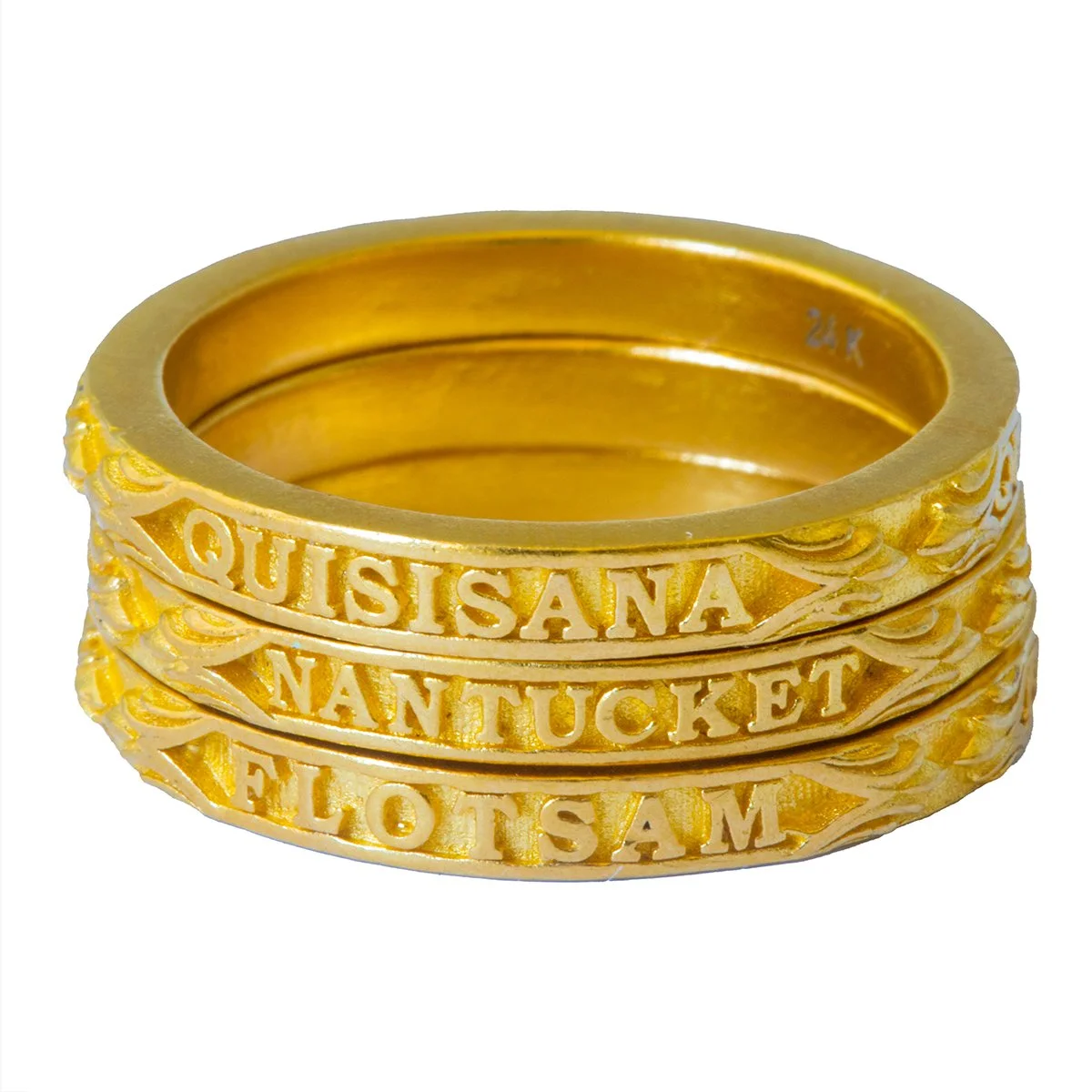utere felix—Use this Happily
My collection is drawn from history, architecture, Nantucket, and the natural world. I am inspired by the ancient 24 carat gold jewelry found in temple treasuries and tombs. I love the rich color and feel of 24 carat gold. Museum antiquities sections worldwide hold these exquisite pieces precisely because they are some of the most impressive and durable objects that have survived through the ages.
Traveling the world, I am drawn to the jewelry traditions of different cultures, collecting pieces rich with history and artistry. I find it fascinating to study each place’s material culture—what iconography resonates, and why? What does a culture value? What are its belief systems? How did people live? These questions shaped my understanding of jewelry not just as adornment, but as a reflection of identity, tradition, and meaning.
Over time, I began making jewelry for myself, inspired by what I had seen and learned. Friends started noticing, asking if I could create pieces for them, and before I knew it, they were encouraging me to sell my designs. What began as a personal passion evolved organically into a business—one rooted in craftsmanship, history, and a love for timeless materials.
My collaboration with a master goldsmith who uses age-old techniques and tools has produced a unique collection of pieces. Like comparing hand-blown glass to mass-produced glass, this hand-made collection of my designs has a character and quality all of its own.
I have found high carat gold jewelry to be especially beautiful. It is the benchmark of fine jewelry in some of the oldest cultures in the world—even now. In ancient places like China, India, Iran, Turkey, and the middle east, high carat jewelry is the bar to which all jewelry is measured.
Some ancient jewelry was dug up quite accidentally when modern developers were in the process of building something new. Imagine being an archaeologist and opening a tomb to find perhaps several hundred pieces of gold jewelry and other artifacts. The gold is often the best preserved of the ancient pieces found because it doesn’t decay when buried. Ancient people thought that pure 24 carat gold—right from the ground—had a certain spiritual and even religious purity because it didn’t want or need man’s intervention to make it beautiful. It came from the earth already beautiful.
In reading about the ancient jewelry found at Oplantis, an archeological site near Pompeii, I was fascinated to learn all that the discovery of jewelry among the victims of the 79AD Vesuvius eruption had to tell us. Similar jewelry sets were found on two young mothers, suggesting that that was the style for young mothers of a certain class to wear. There were silver and gold versions of like pieces, suggesting that one might wear one for dress and the other for more casual occasions or that the metal varied depending on the owner's resources. Some pieces looked very similar to the eye but were made for different markets or by craftsmen of different skill levels. One pair of earrings made of simple gold foil and another made of a much more substantial piece of gold would have had very different price points even then and probably reflected the tastes and disposable income of the owner. Just like today, jewelry varies in material, quality, and value.
One of my favorite facets of looking at jewelry through the lens of history is that not much has changed. In Ancient Rome, it was not unusual for jewelers to engrave utere felix on jewelry, which means "use this happily" in Latin. It’s not a far stretch to think that, while the phrase is a lovely sentiment, it may also be the precursor to what we often say today: "wear it in good health."
In “Leisure and Luxury in the Age of Nero”, Courtney Ward points out evidence for some of the mores around the wearing of jewelry that we might recognize today.
An ancient text shows that-
“Pliney the Elder, for example, disparaged the emperor Caligula’s wife, Lollia Paulina, for attending an ordinary betrothal party inappropriately adorned with emeralds and pearls worth 40 million sestertii. Interestingly, Pliny did not criticize the cost of Lollia’s jewelry, only that she wore it at an occasion that did not warrant such finery.” (Page 174). Pliney (23/24AD -79AD).
This reminds me of the quote attributed to Coco Chanel, in which she is supposed to have said that a woman should get dressed, add her layers of accessories and jewelry, and take off one piece before leaving the house.
Or, an old Upstairs, Downstairs episode in which Lady Marjorie teaches her new lady’s maid her new role. at a weekend house party on a country estate, the maid hands her an extraordinary diamond necklace and Lady Marjorie responds, “Never diamonds in the country, dear”.
While the longitude and latitude of wearing jewelry may have changed, it hasn’t changed much! We are still attracted to quality, artistry, design, and precious materials. My pieces' original design and handmade character are exceptional and worthy of being found a couple of thousand years from now—Somewhere, Somehow.
Stacked Quaterboard rings
For the Investment Minded:
Gold Jewelry as an Asset Allocation
for much of the world; gold jewelry is the place to store a family’s wealth.
The purer the gold, the better.
24K gold is 100% pure gold.
18K gold is only 75% gold.
24K gold jewelry restores the ancient link between
jewelry, savings, and investment.
“Are you looking to invest in something that not only holds value, but also adds a touch of luxury to your life? Look no further than gold jewelry. As the economy becomes increasingly uncertain, many people are turning to gold as a safe and lucrative investment. …
Why Is Gold Jewelry Considered an Investment?
Gold jewelry is often seen as a wise investment due to its enduring value and ability to act as a hedge against inflation and currency fluctuations. Throughout history, gold has consistently maintained its worth, making it a dependable choice for those looking to invest. Furthermore, gold jewelry holds sentimental value and can be passed down through generations, making it a tangible and cherished asset. …
What Makes Gold Jewelry Valuable?
Gold jewelry is highly valuable due to its intrinsic qualities such as rarity, durability, and aesthetic appeal. The purity of gold, measured in karats, significantly impacts its value. Furthermore, the craftsmanship, intricate designs, and historical significance of gold jewelry can also enhance its worth. Market demand, economic stability, and cultural associations also play a crucial role in determining the value of gold jewelry.“
-Better Financial Education, AUGUST 2022
..." the trend is going toward 'wearable jewels'... people have moved away from huge bling and are going towards gold. They're putting money in gold because the price of gold has spiked so much. It seems to be a safer place to put your money, and people are putting it into some fabulous big gold bracelets and chains."...
-Maine Antiques Digest, April 2021
"Men see the appeal of buying gold jewelry as an appreciating asset that has outpaced the stock market returns and that sets the price for other commodities. It's a mainstream idea in Asia, but not so much here in the United States."
-New York Times, April 23, 2021
GLOSSARY
AMALAKA SHAPE
Often used as an architectural element on top of the main tower of a Hindu temple, the shape represents a lotus and symbolizes the seat of the deity below.
Another interpretation is that it symbolizes the sun and is the gateway to the heavenly world.
I have also seen this shape bead made by the glassblowers of Murano, Venice.
AMPHORA
an ancient Greek vessel or container used to transport and store oil, wine, or other commodities.
They date back to at least 4500 BCE.
CHINA TRADE
Nantucket’s whaling economy overlapped with the “China trade,” in which wind-powered ships brought precious porcelain, art, and other valuables back from the Far East.
DORJE
Dorje is a ritual object in Tibetan Buddhism that symbolizes power and firmness of spirit. It has the qualities of a thunderbolt or diamond. In iconography, it is meant to suggest strength, the destruction of ignorance, and the quest for spiritual and mental liberation. Deities are often depicted holding a Dorje.
The Sanskrit word for Dorje is Vajra, and it is a symbol of Hinduism and Jainism as well.
HERAKLES
a divine hero of Greek Mythology. The greatest of the Greek heroes. he was known as Hercules by the Romans.
LA SERENISSIMA
Otherwise known as the Most Serene Republic of Venice, it was a sovereign state and a maritime republic with an expansive empire centered on the lagoon of Venice. Its overseas possessions and far-reaching influence ebbed and flowed between 697 AD and 1797 AD.
MICROMOSAICS
Made in Italy of tiny glass tesserae, these pieces were made mainly for the Grand Tour trade. They were meant to be a high-quality remembrance of a sojourn through Italy. Starting in the 1840s. Some of the best quality micromosaics came from the Vatican workshops. Scenes range from ancient ruins to flowers, animals, and classical symbols. They also evoke Byzantine mosaics dating from 500 AD in Italy and elsewhere.
PLINY’S DOVES
The image comes from a Roman floor mosaic discovered in 1737 at Hadrian’s Villa in Tivoli, which is in turn believed to be a copy of an ancient Greek mosaic at Pergamon.
REPOUSSE
metalwork that is hammered into relief from the reverse side.
RIVIERE
The word Riviere is French for river. A riviere necklace is a necklace made of a continuous line of gemstones of the same color. Riviere necklaces have been popular since the 18th century.
ROSE CUT DIAMONDS
Popular in the 1700s, rose-cut diamonds have a flat base and a domed top cut into distinct facets. The number of facets in a rose-cut stone ranges from 3 to 24, while a brilliant-cut stone has 57 to 58 facets. Rose cuts came before electricity and were made to sparkle under candlelight.
THEWA
A metalwork process using glass and sheets of pure gold, it was created by craftsmen in Partabgarh, Rajasthan, India, in 1767. Made by one family who passed the skills from father to son, the work became popular during the Victorian era and was sold mostly to British women living in or visiting India. Today, one is as likely to find the occasional piece in a British or European antique store as one is in India.
Newsletter
Be the first to know about our new collection
launches, special offers & other updates.





